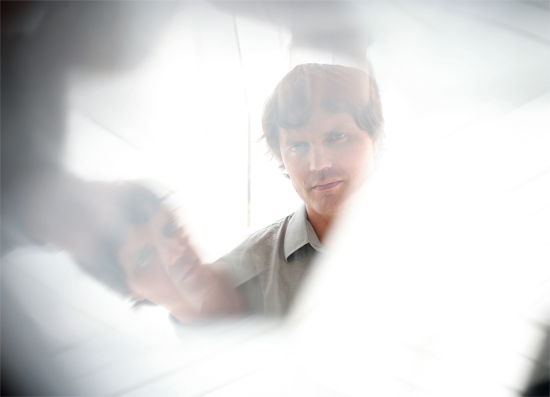We’ve long been a fan of Gyratory System at the Quietus, and are now pleased to announce that the multi-generational treated brass troupe are releasing a new single via the Soft Bodies label on October 7th. We have a premiere of the excellent ‘Harmonograph’ above, accompanied by a great, lurid animation by Jodie Lowther, who also records for the label as part of Quimper. If Gyratory System were once characterised by a strident, militant feel – the horns and soma of Brave New World – this new track sees them heading off down to more bucolic climes. We spoke to Gyratory System’s Dr Andrew Blick to find out what the group have been up to. Dr Blick, Can you tell us a little of what Gyratory System have been up to since the last LP?
Andrew Blick: Mostly recording the new LP! We toured to promote the previous album New Harmony, did a show with Andrew Weatherall, a festival in Switzerland, a few other things. But we wanted to take as much time as we needed to get the recording of the new stuff right. It was mixing that was the most intensive, there are a lot of sounds in there on some of the tracks, and everything has to come out right, so that’s a lot of tweaking.
What in particular was influencing this record?
AB: While working on it I was listening to a lot of Blue Note type 60s New York jazz – Eric Dolphy especially, Andrew Hill – who is a pianist I did not know about until I found out he played with Dolphy – and Joe Henderson, and others. Then there is this album of Armenian music by Jordi Savall, I would recommend his work to anyone. I was also listening to Astor Piazzolla, who wrote tango music. And then I started on the Kompakt label, things like Gas and The Field. And Wagner as well. And Aaron Copeland. But being influenced by things is not the same as sounding like them, so none of the above will necessarily tell anyone what the new album sounds like.
There seems to be a softer, more pastoral feel to Gyratory System now. Would you agree? If so, what’s leading you that way? Are we now talking the Gyratory Systems of ants in the undergrowth?
AB: There is definitely a wider span of moods and textures, and we have longer sections without beats, we have singing, violin, which all stretch things out and smooth them over – except when they don’t. The idea is to take the listener through a whole range of feelings, and we do really tighten the screw in parts as well. The more you listen, the more you hear, like looking at a rock pool – the longer you stare at it, the more diversity you notice.
Can you tell us about the album, and Soft Bodies who are releasing it?
AB: The album is called Utility Music, which is a term first used in Germany in the 1920s to distinguish music for a purpose – like music meant for dancing to – from music which is just music. Which side of that divide we come is for the listener to decide. The album took about two years to come together, which is long for Gyratory System or anything else I have done in fact. It has got all the Gyratory System hallmarks – the processed wind instruments, the programming, the improvised flurries, the shifting repetition, the multi-layered lines. And we have vocals on it for the first time, but they don’t sound like normal vocals.
We then had to find the right label. Soft Bodies seemed right for it. They are doing very good, interesting things. Their aesthetic fitted with what we were doing – complex, but not overblown, sounds which come out at you but not overproduced. They have a compilation out called Soft Bodies Don’t Bleed, which I thought was very good. So we went with them.
How did the video come together?
AB: We are very pleased with the video for ‘Harmonograph’, the next single. It is hard to get these things right but it has captured the mood of the music perfectly. It was made for us by Jodie Lowther, who part of another Soft Bodies act, Quimper. We hope to get her to do another video for us. The video has I think the feel of a Victorian puppet show, which is very much in the mood of the track, which is named after a device that was popular around that time for turning sounds into drawn patterns.
You’ve been doing some collaborative work lately, can you tell us about that? I’m thinking Simon Fisher Turner’s Everest soundtrack.
AB: Simon I have been fortunate to have worked with on and off on various things. He is brilliant and has this touch which is unique. There seems to be a point in his music when there is a change of direction which is surprising but also makes perfect sense. So i am very pleased to be involved in a project where he has created a new soundtrack for the official documentary from 1924 of George Mallory’s doomed attempt on Everest. It combines my three main interests really, music, films and history. And Simon has put together a great team of people to play music live at the premier so i am looking forward to it.
What plans to Gyratory System have for the rest of 2013?
AB: We will have another single out, probably ‘Old Harmony’ towards the end of the year, and be building up to the release of Utility Music, all on Soft Bodies. There will certainly be more recording of new music, some Gyratory System, some for other things, some returns to earlier things as well. So keep listening.


